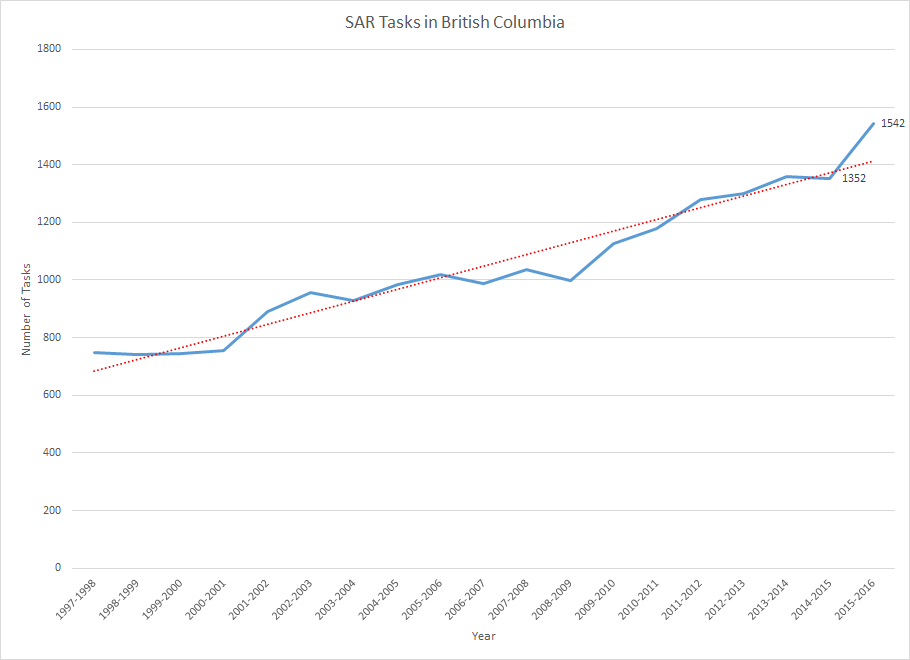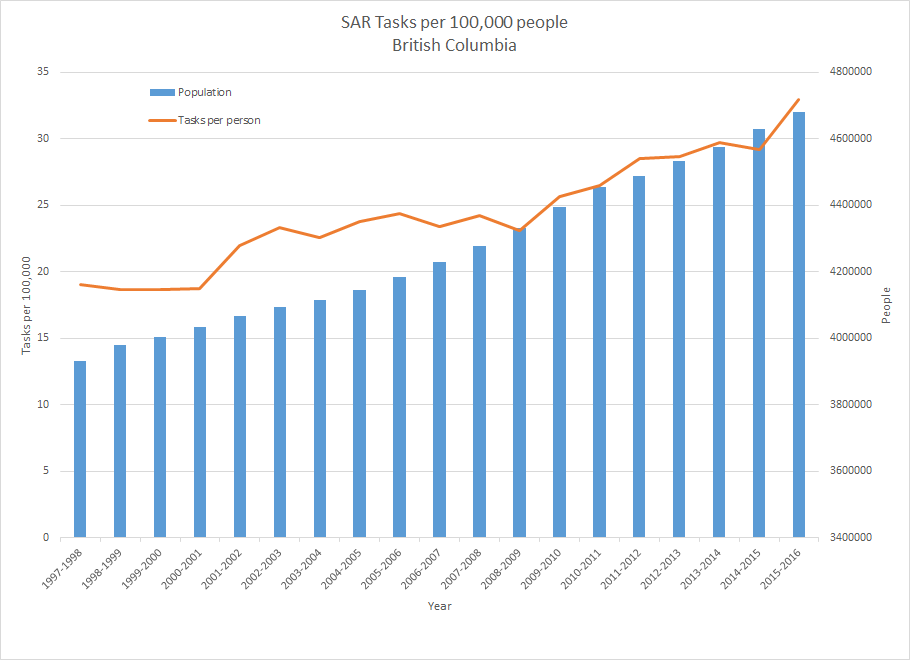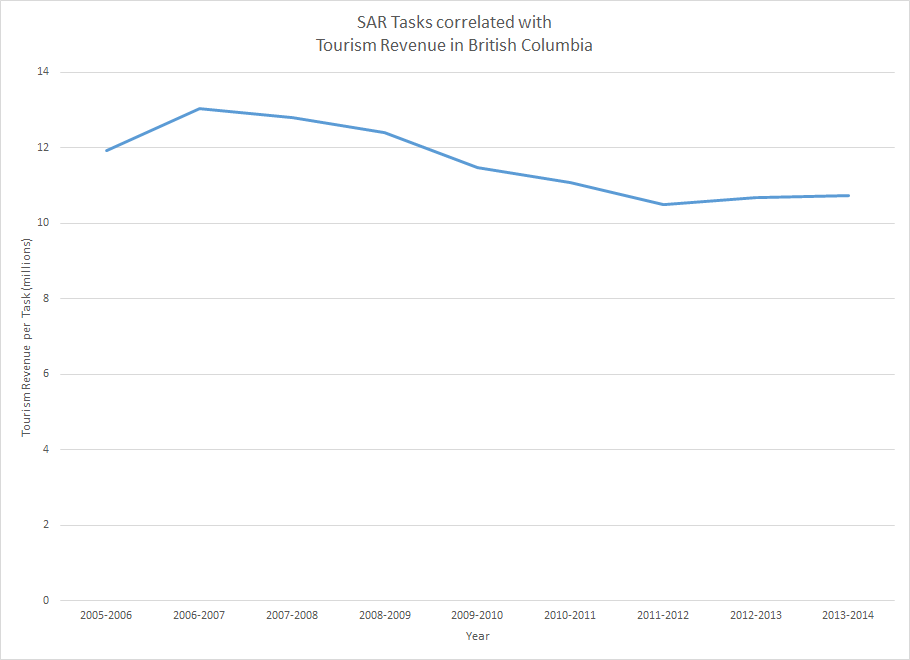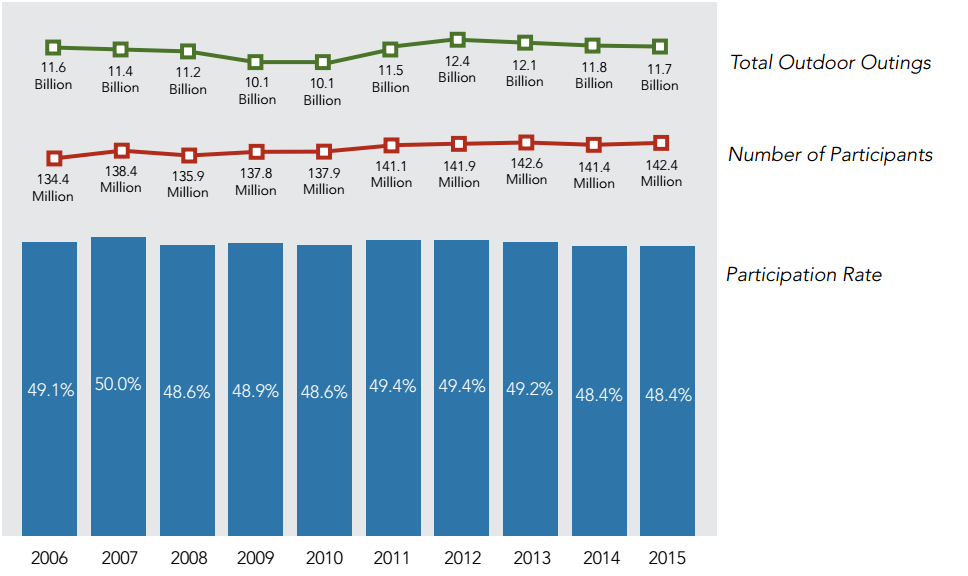SAR Call Volume Trends

Last week I published a post showing how the 2015-2016 year was unusually busy one for SAR groups in British Columbia. That one dealt with the number of people rescued, and at the end of it I uncovered one of the reasons for the unusual spike – three rescues of groups of over 20 people each.
However, even taking into account those people, 2015-16 was clearly a year of unusually high call volume.
Overview:
- The number of SAR tasks over the past 19 years has increased on average by 40 a year or 6%
- The increase from 2015 to 2016 was 190 tasks, or 14%
- This was 140 tasks over the long term average

Methodology
This chart shows the number of SAR tasks per year since 1997. Emergency Management BC publishes a report every year, and this data is derived from those reports. EMBC tracks data through the financial year so for example 1997-98 tracks April 1st 1997 to March 31st 1998. So each financial year will measure predominantly the summer of the year it starts in (as SAR call volumes spike in the summer). I’ve chosen to chart SAR task totals, and exclude evidence searches and body recoveries as I feel this better represents the core SAR competencies. Avalanche responses (which EMBC tracks separately) are also not included but there’s only one or two of those a year so they are not significant.
On the chart I included the number of tasks for the last two years as data points. I also included a linear trend line showing the regression for this 19 year period.
Analysis
The trend line has an R²=0.94 which indicates is good fit to the data. The trend line equation is y = 40.447x+644.68
This indicates that the number of SAR tasks in BC increases on average by 40 every year, or about 6% per year.
The 2015/16 year saw this increase rise to 190 tasks or 14% – a full 150 additional tasks over the long term average.
Discussion
It can be tempting to look at a jump in call volume over a single year and try to draw conclusions about it, but that’s usually a mistake. Long term trends are what is important. As an example, many of us recall the summer of 2003 when the BC Government “Closed the backcountry” due to extreme fire danger. By one account, this resulted in a relatively quiet late summer for SAR groups with 60 fewer SAR tasks overall during that period. However looking at the long term chart (financial year 2003-2004), while we see a significant inflection point, we don’t see a change in the long term trend.
Also over this 19 year period we do not see any appreciable slowing in the number of SAR tasks. As a reference point, the iPhone was introduced in summer 2007, and since then smart phone adoption in Canada has reached 75%. Most people are carrying a navigation device in their pockets that should prevent them from getting lost. Still, SAR tasks increase. I feel that the people we rescue are lacking in skills and not the tools – which highlights that education is still the way to go to prevent SAR.
Of course this data set only shows number of SAR tasks and not the reason why people are calling SAR. It’s quite possible that it is showing a decline in people getting lost, and an increase in people needing rescue (due to injury, misadventure or over estimating their abilities). In fact this is what most SAR teams are reporting anecdotally – that their number of searches (where the person is lost) are down, and the number of tasks where the person calls for help on their cell phone are increasing. The other trend is that these responses are getting shorter, but consequently feel more urgent.
SAR Tasks not driven by population
In any trend involving people the first assumption is that it is driven by population increase – that there’s some constant proportion of the population participating in outdoor activities, and due to the growth in population the number of people participating (and hence being exposed to hazard, and requiring SAR) is increasing in proportion to that. To examine this we can take population numbers for British Columbia and plot them against the number of SAR tasks to come up with “SAR Tasks per 100,000 people” – a technique that’s used by demographers.

What’s notable about this chart is this – if the number of SAR incidents were linked directly to population, you would see a relatively flat line for “Tasks per person” which would represent the proportion of the population that requires rescue. You can see this to some extent for first four years of the data, and it could be the case for 2003 to 2009 as well, but the long term trend is upward – with an increase from approximately 20 tasks per person to over 32, or an increase of 68% over 19 years of the data.
And just in case you’re fooled by the slope of the people per task line being similar to the population slope – that’s not what we’re looking at on this chart. The people per task like should be relatively flat if the population were driving the SAR Tasks.
So what is driving SAR Task volume?
Speculation
When I posted the charts above online earlier last week there was some speculation that social media was to blame. This is quite possible, but the evidence is not conclusive. My personal experience has not indicated to me that people are getting lost because of social media specifically. However, social media adoption rates in Canada are high (although not as high as people think they are), and many people think that they can get all of their information from the internet.
This may lead people to believe they are prepared for a certain activity when they are not. Over estimating abilities, and under estimating conditions are the two main reasons people need rescuing, and also get better with experience. However, they are both notoriously difficult to teach, especially since they require judgement – something that usually comes with experience. Perhaps social media and internet based information is giving people the false impression that they are prepared when they aren’t.
Back in the 90’s if people wanted to do an outdoor activity they would join a club and usually learn from more experienced people. This could take the form of beavers, cubs, scouts and guides, or just your local mountaineering clubs. With online forums people began getting their information from less reliable sources, and it’s hard to say if things have gotten better or worse in the succeeding years.
Backcountry Participation
The other major question is whether there’s some other major driver of people to the backcountry. In the US there’s the Outdoor Industry Association Outdoor Recreation Participation Report which shows that backcountry participation rates are flat over the past decade. This may not be applicable to BC, as many people I talk to say that they have seen a large growth of backcountry use in the areas of the Sea to Sky corridor.
Tourism
Finally there’s tourism. I took tourism data from the Province of BC and plotted it against SAR tasks (Tourism revenue per task in millions) and I came up with the following chart.

This is a very rough correlation. Tourism revenue is from all sources of tourism spending and not just backcountry. However, here we are using it as a proxy for the total volume of tourism in British Columbia, and other research shows that most people come to BC for outdoor activities – the assumption being that the proportion of tourists using the backcountry is constant. It’s rough, but this chart shows the flat relationship between two signals that I am looking for when I’m trying to find a correlation.
The data shows that it;s possible, but logic also shows that it’s probably that the growth of SAR in BC is driven by tourism. Tourists are usually less experienced in our terrain and are the most unfamilair with a trails, conditions or routes. They represent the highest risk even if they are skilled in their sports.
Summary
SAR Tasks are increasing over time. It’s not clear why, but we don’t believe it’s driven by population increases, or by social media, or by an underlying increase in interest in outdoor activities. It is possible they are driven by tourism.
We do know that technological improvements and prevention activities do not seem to be having a measurable effect on the rates – we don’t seen an inflection that would indicate a change in the underlying rate,
It’s clear from the lack of data that the SAR community in BC would be very well served by more advanced analytics. These would give us a better idea of who is needing SAR and why, so that prevention and education activities could be better targeted.


Thanks for your article and thoughts on the number of sar rescues. We here in Gallatin county , montana, also experienced a sharp rise in calls over the last year.
Your analysis is interesting and gives good food for thought.
Thanks
Don Wilson
Gallatin county SAR
Thanks for the kind words Don.
I don’t usually consider things outside of the British Columbia / Canada perspective, but it is possible this is a larger phenomenon than I thought!
Great article and thanks for the work you put into this. I get the same way when something intrigues me to try and find the answer(s), and i think you hit the nail on the head in suggesting more content in the data stream for SAR activities. As a soon to be qualified TL, this data would ring alarm bells to me, and I would want to know if there would be more as a group a SAR team could do to reduce those numbers. Is it more uneducated (outdoor wise) people getting out in the wilderness?… More people taking risks beyond there ability level?… Or maybe just more “uncontrollable incidents” (I dont like the word accident.. lol)? …. Would there be a way to collect and maintain some of this data by possibly adding or using other fields in the SAR KMS? I know this year, our group is going to put a huge push of PSAR in the area from schools, events, and even in the parks…. Im a firm believer that if everyone carried just the basics, and have a basic knowledge of outdoor travel, numbers would go down and good outcomes increase.
Owen Parker
Parkland SAR – SK
We have a huge project underway to address this issue. Members of BCSARA are working on the RFP to create a database that will address tracking training, equipment, and SAR responses including detailed subject information and one of the specifications for this system is that it will upload the data to the SAR KMS.
I can’t wait for it to be active, I feel like I’ve been writing about this for 10 years (but it’s only been 5).